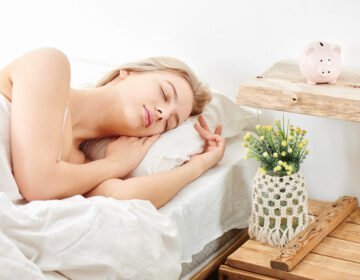
Creating the Perfect Sleep Environment
The right place to sleep is important if you want to get a good sleep and wake up feeling refreshed. The way your bedroom looks is very important for getting a good night’s sleep. Everything affects how well you sleep, from the bed and mattress you choose to the lighting and temperature control.
In this blog, we will talk about many bedroom design tips that will help you make the better place to sleep. We will talk about how important it is to choose the right bed and mattress, make sure the room is well, keep noise out, control the temperature and air quality, choose calming colors and aesthetics, make the room feel calm, and more.
By making your bedroom a great place to sleep, you can improve your health and the quality of your sleep. So, let’s get started and find out how to set up the right place to sleep in order to get a good sleep and feel ready to start each day.
Choosing the Right Bed and Mattress
Getting the right bed and mattress is important for making your room a good place to sleep. How comfortable and supported you are while you sleep depends a lot on your bed and mattress. Here are some important things to remember:
Comfort: Choose a mattress that provides a balance of softness and support. Different people have different preferences, so choose a comfort level that suits your needs.
Size: Consider the size of your bed based on your sleeping comfort and available space. A larger bed, such as a queen or king size, allows for more room to move around and reduces disturbances if you share the bed.
Mattress Type: There are many types of mattress available such as memory foam, latex, and hybrid. Each type has its unique characteristics, so research and test different options to find the one that suits your preferences and sleep style.
Support: Look for a mattress that provides proper support for your body, particularly for your spine. It should align with the natural curves of your body and distribute your weight evenly.
Optimal Lighting for Sleep
Your bedroom’s lighting is a big part of your sleep-wake cycle and helps you get a good night’s sleep. Here are some tips for setting up the right lights so you can sleep better:
Natural Light: During the day, expose yourself to natural sunlight as much as possible. Open curtains or blinds to let in natural light, which helps regulate your internal body clock and promotes wakefulness.
Dim the Lights: In the evening, dim the lights in your bedroom to signal to your body that it’s time to prepare yourself for sleep. Use soft, warm-toned lighting sources like table lamps with adjustable settings to create a cozy atmosphere.
Avoid Blue Light: Blue light emitted by electronic devices such as smartphones, tablets, and TVs can disturb with your sleep quality. Minimize exposure to screens at least one hour before bedtime or use apps that reduce blue light emission.
Use Blackout Curtains or Eye Masks: If external light sources, such as streetlights or early morning sunlight, disturb your sleep, consider using blackout curtains or blinds to block out unwanted light. Alternatively, use a comfortable eye mask to create a completely dark environment.
Nighttime Lighting: Install low-intensity nightlights or use motion-activated small lights in your bedroom or hallway to provide guidance during nighttime without disturbing your sleep. Opt for soft, warm-toned LED bulbs that emit less disruptive blue light.
Soundproofing and Noise Reduction
Seal Windows and Doors: Check for any cracks around your windows and doors that may allow noise to enter. Use weatherstripping or draft guards to seal these gaps and reduce sound transmission.
Install Thick Curtains or Blinds: Hang heavy, thick curtains or blinds over your windows to block out external noise. Opt for curtains made from noise-reducing materials or add an extra layer of soundproofing fabric to enhance their effectiveness.
Use Acoustic Panels or Soundproof Wallpaper: Consider installing acoustic panels or soundproof wallpaper on your bedroom walls to absorb and reduce sound vibrations. These materials can help create a quieter sleep environment.
Soundproof the Floors: If you live in an apartment or have noisy neighbors below, add rugs or carpets to your bedroom floor to help absorb sound. You can also use soundproof underlayments or floor mats to minimize noise transmission.
Temperature and Air Quality Control
The temperature and air quality in your bedroom play a crucial role in creating a comfortable sleep environment. Here are some tips to help you regulate temperature and improve air quality for better sleep:
Optimal Temperature: Keep your bedroom at a cool and comfortable temperature for sleep. The ideal temperature range is typically between 60 to 67 degrees Fahrenheit (15 to 19 degrees Celsius). Experiment to find the temperature that suits you best.
Use Bedding Suitable for the Season: Choose bedding materials that are appropriate for the current season. Use lightweight, breathable sheets and blankets during summer and warmer months, and opt for warmer, insulating bedding during winter to maintain a comfortable sleep temperature.
Adjust Ventilation: Proper ventilation is essential for maintaining good air quality. Ensure that your bedroom has adequate airflow by opening windows, using a fan, or adjusting the air conditioning or heating system. Fresh air can promote a more restful sleep experience.
Control Humidity: Keep the air in your bedroom at a good level. Too much or too little can affect how well you sleep. Use a humidifier or dryer to control the level of humidity and make a comfortable place to sleep.
Conclusion
Getting a good night’s sleep requires a lot of different things, but weather and air quality are two of the most important. By using the tips above, you can make your bedroom a place where you can sleep well and improve your health.
A comfortable sleep setting includes keeping the room at the right temperature, using the right bedding, and making sure there is enough air flow. Air quality can be improved by controlling humidity levels and using air filters. These changes make the room more peaceful and relaxing, which will help you sleep better.
Keep in mind that everyone has different tastes, so it’s important to figure out what works best for you. Try out different temperature settings and ways to control the air quality to create the best sleeping conditions for your needs and to help you sleep well.















